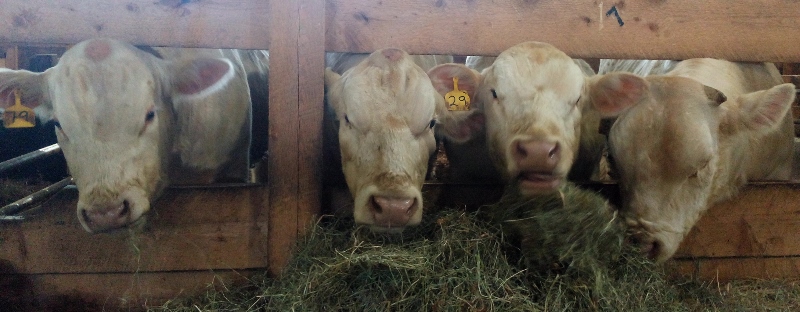A broad research program is revealing insights to benefit beef cattle productivity while providing training for academics and technology transfer on the East Coast.
Led by Dr. Yuri Montanholi, Assistant Professor at the Agricultural Campus of Dalhousie University (Truro, Nova Scotia), a group of “beef cattle enthusiasts”— whom Dr. Montanholi kindly refers to as his associates—has been researching beef cattle biology to understand the variation in efficiency of feed utilization. The group works to identify proxies for feed efficiency and for other complex traits (i.e. reproduction, behavior).

Two years ago Dr. Montanholi implemented a successful beef cattle research program in the Maritimes. With help from the Maritime Beef Testing Station, a community-run facility located in Nappan, Nova Scotia and commercial beef cattle producers across the three provinces, researchers have access to cattle individually monitored for feed intake—the key for studying bio-indicators for feed efficiency. Cattle brought to the station are submitted to a routine productive performance evaluation with body weight and body composition (via ultrasound scanning) assessments every 28 days for a period of 112 days. This information together with individual feed intake constitutes the direct assessment of feed efficiency, which is the basis for evaluating the effectiveness and reliability of potential proxies for feed efficiency.
Over the last 20 years a measure of feed efficiency—residual feed intake (RFI)—became part of the evaluation of commercial bulls and also the basis from which to study the biology underlying feed efficiency. Dr. Montanholi explains that this assessment takes into consideration the individual feed intake of an animal while accounting for its size, rate of growth and body composition (leanness and fatness) in relation to its herd. Thus, if after accounting for all these energy “sinks” a negative RFI value is observed, the animal is considered feed efficient since it is consuming less feed than what would be expected, whereas a positive RFI value indicates inefficiency. The economic and environmental benefits of feed efficient cattle (which some Maritime beef producers have coined “easy-on-groceries cattle”) are tremendous.
“We recently evaluated over 100 grass-fed heifers for feed efficiency and when the 10% most and least feed efficient heifers where compared, results indicated that an efficient heifer can consume 4 fewer bales of hay (1600 kg) per animal on a yearly basis while achieving the same productive performance as inefficient heifers. These potential savings in feed costs occur without affecting carcass size and composition, representing a real increase in (fuel) efficiency,” says Dr. Montanholi.
Despite the benefits of improving feed efficiency in the beef industry, the large-scale identification of feed-efficient cattle in commercial herds is a limitation for advancing genetics and nutrition programs. “With that said, we have been focusing on identifying proxies for feed efficiency mainly rooted in major energetically demanding processes of the cows’ bodies. This search involves extensive cattle handling and sample collection, which is shared within our research group and consists of long hours at the barn, thousands of samples to manipulate and endless data sheets to interpret. Currently our research is focused on heart function, reproduction, blood metabolites, liver metabolism and rumen physiology.”
The heart function research, led by Jasper Munro (M.Sc. student), is characterizing heart rate patterns of cattle overnight during rest and upon exposure to an acute stressor (i.e. the sight of an opening umbrella while in the chute). Heart rate is recorded using a monitor fastened around the heart girth and secured carefully with leather straps and tape (lots of tape!). Results are indicating that feed-efficient cattle have a lower heart rate during rest but higher heart rate upon the sudden opening of an umbrella in comparison to feed-inefficient cattle. These observations open perspectives for assessing feed efficiency based on heart rate. Munro’s extensive efforts resulted in first place presentations at the 75th Meeting New Zealand Society of Animal Production and also at the 66th Meeting of the European Society of Animal Production.

Breeding soundness and sexual maturity in the context of feed efficiency is another major portion of our research program. Stéphanie Bourgon, recipient of a Masters Scholarship from NSERC co-sponsored by the Semex Alliance, has been evaluating the intricate associations between feed efficiency and fertility-related measures in young beef bulls. “Here our focus isn’t so much to find proxies for feed efficiency, but rather to monitor potential antagonistic relationships between improved feed efficiency and sexual maturity that may influence the reproductive capacity of a bull,” says Dr. Montanholi. This antagonism has been well-documented in other farm animals in response to increased productivity. In general, Bourgon’s research is hinting towards delayed sexual maturity in feed-efficient bulls, as indicated by sexual hormone profiles, testis echogenicity and scrotum development. “Our target is to contribute to the identification of bulls that are both feed efficient and exhibit desirable development of the reproductive system—bulls that most farmers want to see grazing (and breeding) in their fields,” reinforces Dr. Montanholi.
The cow herd is also a focus of the group’s research on reproductive physiology. Ellen Crane (M.Sc. student) is heading an investigation to further understand the metabolic profile of estrus and how a long list of blood cell types, immunoglobulins, hormones and metabolites could be informative about feed efficiency. Among other interesting biological clues, her investigation is indicating an increased oxygen carrying capacity in the bloodstream of less feed efficient cattle. “This is suggesting that inefficient cattle may need more oxygen to keep up with their metabolic demands, similar to the increased fuel needs of an inefficient car,” Dr. Montanholi explains. Crane has been involved with industry functions including the Canadian Hereford Association and the Cattleman Young Leaders. She is also the current recipient of the prestigious Keith Gilmore Foundation Beef Cattle Innovation Prize.
With the assistance of the National Research Council in Halifax, we were able to “map” blood plasma metabolites over the circadian period in young heifers across different stages of growth and gestation. Results were presented by Alaina Macdonald (Veterinary Medicine student) at the annual meeting of the European Association of Animal Production. “This was an awesome presentation; colleagues were congratulating me for the great ‘Ph.D. student’ with Alaina still working on her undergraduate degree,” highlights Dr. Montanholi. Macdonald also prepared a scientific article about proxies for liver abscesses in beef cattle, a health threat with significant costs to the industry. Her study defined blood parameters (i.e. albumin, cholesterol) associated with the presence or absence of abscesses. The results of this study may assist with the detection of abscesses to inform management decisions and may serve in the development of complementary tools for inspectors at slaughterhouses.
The rumen has a well-established role in the efficiency of feed utilization. Stephanie Lam, recipient of the Queen Elizabeth II Masters Scholarship from the University of Guelph, has been working on understanding the relationship between digestive physiology and rumen microbial ecology with feed efficiency. The question is: are there associations between rumen microbiology, rumen histology, rumen metabolites, rumen pH and temperature with feed efficiency? It will certainly take many years to address these points in great depth, but Lam’s research is definitively shedding light on these topics. In part, her research has indicated a greater abundance of volatile fatty acids—important energetic “coins” for cattle, among other functions—in cattle with improved efficiency fed either corn- or grass-based diets. “I foresee that Stephanie’s research will serve as a basis for developing the means to identify cattle feed efficiency. In the long run, the characterization of rumen parameters may serve to assign cattle to different rations according to their metabolic profile, which is the other way around to improve feed efficiency,” says Dr. Montanholi.
“Our diverse research program also serves to foster training and extension. It is a priority to ensure that students excel in communicating their research, not only to academics but also to extension personnel and beef producers. This is a key skill for professionals working with applied biology in Agriculture. It does take a lot of practice to adjust the wording and still maintain the science behind it,” says Dr. Montanholi. This practice comes from innumerous opportunities to talk to beef producers during the traditional “AGM” meetings of different associations, regional meetings, open houses and bull sales. During these events, practical scientific information is delivered through presentations, factsheets, and conversations by our booths and demonstrations. “This is both a great investment of our time and lots of fun! It is also our opportunity to give back to those who greatly support our research.”
The research and extension initiatives that Dr. Montanholi is currently involved in are funded by the Beef Cattle Research Council, Agriculture and Agri-Food Canada, Natural Sciences and Engineering Research Council of Canada, Agriculture Adaptation Council, Beef Farmers of Ontario, Nova Scotia Cattle Producers, New Brunswick Cattle Producers, Prince Edward Island Cattle Producers, Nova Scotia Department of Agriculture, Maritime Beef Council and Semex Alliance. Dr. Montanholi’s group is also appreciative for the substantial in-kind support from Beef Improvement Opportunities and Maritime Beef Producers.
Dr. Montanholi can be contacted at yuri.r.montanholi@gmail.com












